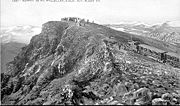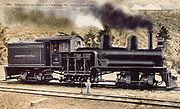
Argentine Central Railway
Encyclopedia


United States
The United States of America is a federal constitutional republic comprising fifty states and a federal district...
built from the Colorado and Southern Railway
Colorado and Southern Railway
The Colorado and Southern Railway was a railroad company in the western United States that operated independently from 1898 to 1908, then as part of the Chicago, Burlington and Quincy Railroad until it was absorbed into the Burlington Northern Railroad in 1981.The railway began as the...
at Silver Plume, Colorado
Silver Plume, Colorado
The historic Town of Silver Plume is a Statutory Town located in Clear Creek County, Colorado, United States. Silver Plume is a former silver mining camp along Clear Creek in the Front Range of the Rocky Mountains...
to Waldorf, Colorado (now a ghost town
Ghost town
A ghost town is an abandoned town or city. A town often becomes a ghost town because the economic activity that supported it has failed, or due to natural or human-caused disasters such as floods, government actions, uncontrolled lawlessness, war, or nuclear disasters...
) and onward to the summit of Mount McClellan. Construction began on August 1, 1905 and the line was opened a year later on August 1, 1906. It was financed and organised by Edward J. Wilcox, owner of 65 mining properties in the Argentine region that were consolidated into the Waldorf Mining and Milling Company in 1902. His headquarters at Waldorf was accessible only by pack mule for much of the year.
As well as serving the silver
Silver
Silver is a metallic chemical element with the chemical symbol Ag and atomic number 47. A soft, white, lustrous transition metal, it has the highest electrical conductivity of any element and the highest thermal conductivity of any metal...
mining
Mining
Mining is the extraction of valuable minerals or other geological materials from the earth, from an ore body, vein or seam. The term also includes the removal of soil. Materials recovered by mining include base metals, precious metals, iron, uranium, coal, diamonds, limestone, oil shale, rock...
operations of the region, the railroad was also intended for the tourist trade, ascending 13587 ft (4,141.3 m) Mount McClellan and intending to reach the summit of 14,270 ft (4,350 m) Grays Peak
Grays Peak
Grays Peak is the highest mountain in the Front Range of the Southern Rocky Mountains in the U.S. State of Colorado. It is one of 54 fourteeners in Colorado. Its nearest major city is Denver. The first man to ascend Grays Peak, botanist Charles C. Parry, named the peak for his botanist...
nearby. It was believed at the time that Mount McClellan was 14007 ft (4,269.3 m) high, but this was later disproved. It remains the highest altitude reached by a regular adhesion railway (as opposed to a rack railway
Rack railway
A rack-and-pinion railway is a railway with a toothed rack rail, usually between the running rails. The trains are fitted with one or more cog wheels or pinions that mesh with this rack rail...
) in the United States
United States
The United States of America is a federal constitutional republic comprising fifty states and a federal district...
.
The line was steeply graded and sharply curved, with a standard of 6% grade maximum and 32° minimum curvature; even so, it required six switchback
Zig Zag (railway)
A railway zig zag, also called a switchback, is a way of climbing hills in difficult country with a minimal need for tunnels and heavy earthworks. For a short distance , the direction of travel is reversed, before the original direction is resumed.A location on railways constructed e.g...
s on the ascent. Due to these grades, geared steam locomotive
Geared steam locomotive
A geared steam locomotive is a type of steam locomotive which uses reduction gearing in the drivetrain, as opposed to the common directly driven design....
s were used exclusively, the railroad rostering a total of seven two-truck Shay locomotive
Shay locomotive
The Shay locomotive was the most widely used geared steam locomotive. The locomotives were built to the patents of Ephraim Shay, who has been credited with the popularization of the concept of a geared steam locomotive...
s.
As well as ascending Grays Peak, Wilcox also intended to bore a tunnel to reach Keystone, Colorado
Keystone, Colorado
Keystone is a census-designated place in Summit County, Colorado, United States. The population was 825 at the 2000 census. The Dillon Post Office serves Keystone postal addresses....
and the Denver, South Park and Pacific Railroad
Denver, South Park and Pacific Railroad
The Denver, South Park, and Pacific Railroad was a historic narrow gauge railway that operated in Colorado in the western United States in the late 19th century. The railroad opened up the first rail routes to a large section of the central Colorado mining district in the decades of the mineral boom...
. The tunnel was reported three-quarters complete in 1914, but economic conditions never permitted completion.
The fall of silver prices after the Panic of 1907
Panic of 1907
The Panic of 1907, also known as the 1907 Bankers' Panic, was a financial crisis that occurred in the United States when the New York Stock Exchange fell almost 50% from its peak the previous year. Panic occurred, as this was during a time of economic recession, and there were numerous runs on...
ruined Wilcox, causing him to sell the railroad in 1908 for only $44,000, taking an estimated loss of $256,000 on the line. The buyer, David W. Brown of Colorado, planned an expansion in the tourist traffic and revitalised the concept of reaching Grays Peak, but the money was never there. The line went bankrupt and a receiver was appointed on August 3, 1911; it did not operate during 1911 and 1912.
A consortium of local business interests led by William Rogers bought the railroad for $20,000 on August 19, 1912 and reorganized it as the Argentine & Gray's Peak Railway. While the new owners were mostly interested in freight traffic, the tourist business brought in sufficient money that it was resumed for the 1913 summer season. Rogers transferred the controlling interest in the line for the next season to his associate, egg producer Fred W. Blankenbuhler.
Blankenbuhler replaced the Shay locomotives with gasoline-powered railcars for the 1916 season, but even this cost-saving measure did not make the railroad profitable without the freight traffic it had previously carried. Notice to abandon was posted on October 24, 1918 and approved on November 9; the tracks were removed by 1920.

